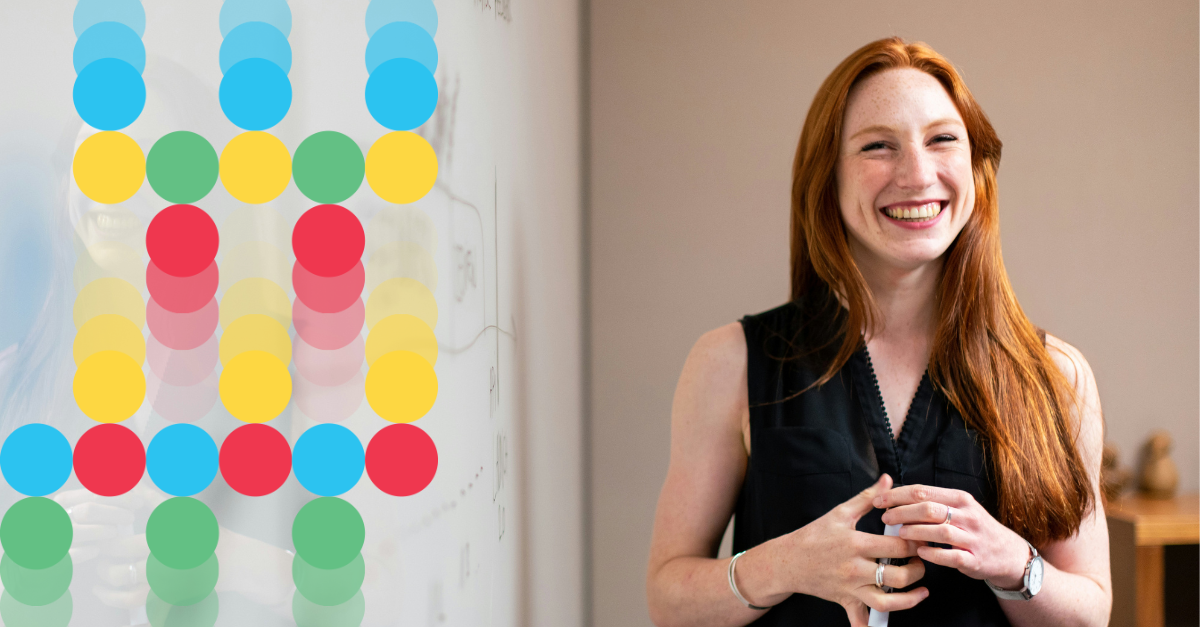Your team is trying to solve a thorny problem or generate a breakthrough idea. How do you approach the challenge? What’s your go-to creative tool for collaborative brainstorming sessions?
Your first instinct might be to schedule an open, freewheeling brainstorming session and see what happens. That’s one way to go, but it's not necessarily the best way. And on its own, that big brainstorming meeting probably won't create the boundary-pushing collaborative ideas and solutions you need.
If the traditional brainstorming process isn’t the answer, then what is? You want team brainstorming that combines quantity and quality. We’ll explain why traditional brainstorming isn’t working and how you can use Whole Brain® Thinking to jump-start collaborative brainstorming and power up your team.
Why Traditional Brainstorming Doesn’t Work
The assumption with traditional brainstorming is that you’ll come up with tons of ideas, many of them off-the-wall and wacky. From there, a few of them might end up being the kernel of a groundbreaking solution or opportunity.
Following that line of thinking, managers will call team meetings, usually set around a conference table. They set a timer and everyone freely shares their thoughts about the topic while someone diligently takes notes. Some team members might participate, but many will sit quietly. These exercises can quickly become about quantity instead of quality.
People rarely leave those collaborations feeling exhilarated by all the creative thinking they’ve done. Usually, they realize their piles of ideas are more iterative than inventive — one or two steps away from what they’ve already been doing.
What happens next? Many times, nothing. Seldom does anyone ever go back to the brainstormed list of ideas, nor is there much deep thinking about what to do with all that stuff. Not exactly the innovation jump-start you were looking for.
You’re left with lots of ideas, but you’re not necessarily closer to the groundbreaking solution you initially sought. It’s no wonder brainstorming has drawn criticism over the years. You need quality ideas, not just sheer quantity. And you need productive brainstorming that’s truly collaborative and leverages the strengths of Whole Brain® Thinking that your team might already be using.
Defining Collaborative Brainstorming
Collaborative brainstorming is a technique when a group of people comes together to generate ideas and potential solutions to problems. This process can occur through face-to-face discussion, online collaboration, or a combination of both.
This type of brainstorming is especially helpful when a group needs to generate ideas quickly or when a problem is too complex for one person to solve on their own.
In a collaborative brainstorming session, people work together to generate as many ideas as possible without judging or critiquing them. This can help to encourage creative thinking and can also help to prevent people from getting stuck on one idea.
3 Benefits of Ideas Collaboration
Brainstorming with your team can benefit you in many ways. Here are just a few.
Increased Diversity of Ideas
Sign up to our newsletter for the latest insights
This aligns with Whole Brain® Thinking’s emphasis on cognitive diversity, which also includes people’s backgrounds, skills, and strengths.
Improved Team Cohesion
When people come together to share their ideas without judgment, you create a more cohesive team environment and focus everyone on the common goal. No longer are people withholding potential solutions because they don’t have a forum or don’t feel safe speaking up. Your team members get to know each other better by proposing and iterating on each other’s ideas.
Greater Sense of Ownership
Collaborative brainstorming contributes to people’s sense of ownership and buy-in because everyone has a forum for participation. You receive more ideas while showing employees that they have a voice in the decision-making process.
The net result is that your people see how their work contributes to the business strategy. They’ll be more willing to support the next steps, even if the plan isn’t exactly what they would have done.
6 Techniques for Collaborative Brainstorming Sessions
Collaborative brainstorming comes in many forms. Here are just some of the popular approaches.
Brainwriting
With this technique, team members quickly generate ideas without the pressure of publicly revealing their source. For example, each person in the group writes down their ideas on a piece of paper and then passes the paper to the person next to them. Ideas are collected and shared with the group, who vote for the best ideas. The thinking here is that this approach allows people to share their ideas more freely and in a more time-effective manner.
SWOT
To help identify new business opportunities and develop strategies to overcome weaknesses and threats, try the SWOT (Strengths, Weaknesses, Opportunities, and Threats) approach.
SWOT is popular for helping businesses identify internal and external factors that could affect their chances of success. Your team can use SWOT exercises to assess the potential risks and rewards of new collaborative ideas. After identifying these factors, you can develop strategies to capitalize on strengths, overcome weaknesses and mitigate any threats.
Rapid Ideation
To generate many concepts in a short time, try rapid ideation. This approach to brainstorming focuses on generating a high number of ideas in a short amount of time, without worrying about quality or feasibility. This can help you explore the full range of potential ideas, especially if your team is quick to jump into analysis and shoot down possible solutions.
Mind Mapping
Brainstorming with a mind map will help create new ideas by visually organizing everyone’s thoughts. This approach helps visualize connections between ideas and find new ways to combine them. Mind mapping can also help you track and remember the group’s thinking. Begin this visual collaboration process by starting with a central idea and branching out.
Whiteboard Brainstorming
This process is as it sounds: Gather around a whiteboard and encourage employees to take turns adding ideas. The goal is to come up with a high volume of ideas without judgment or criticism while collecting all those ideas in a central, visible location in a physical space.
Whole Brain® Thinking
The Whole Brain® Thinking approach emphasizes cognitive diversity and embracing your team’s different thinking perspectives, and collaborative brainstorming is one of the most direct ways to apply this approach.
Encourage your team members to share their perspectives while deliberately seeking the viewpoints of people who default to different thinking styles than theirs. For example, if you’re trying to reduce operational costs, Blue thinkers might first think of logical, quantitative approaches, while Red thinkers can contribute valuable insight into the emotional and interpersonal implications of different cost-cutting measures.
5 Brainstorming Tips that Improve Team Collaboration
The Whole Brain® Thinking model helps people understand and consider their thinking, as well as the thinking of others. It's based on the premise that we use different parts of our brains for different tasks and that we can learn to use all parts of our brains more effectively.
Use Whole Brain® Thinking to make these common brainstorming tips even more productive.
Establish a Clear Goal
Before you kick off your brainstorming session, establish the goal and check for understanding. This focuses everyone’s efforts and prevents the frustration generated by misunderstandings. With everyone agreeing on the goal, they can tailor their ideas and thinking to the most relevant and useful proposals for a successful collaboration.
Respect Everyone’s Ideas and Opinions
Brainstorming requires mutual respect to be successful. People will hold back valuable ideas and input if they believe they’ll be penalized for sharing their informed opinion. Everyone should feel respected and valued, even if their ideas aren’t ultimately adopted.
Give a Voice to the Shy Ones
Cognitive diversity recognizes that great ideas come from everyone, not just the biggest personalities, loudest voices or the most eager contributors. Create space for everyone to actively participate. Sometimes that means finding alternative avenues for offering feedback, such as anonymous, written contributions alongside in-meeting discussion.
Encourage Creative Ideas
No idea is a bad idea when it’s given in good faith and in pursuit of the goal. The more your people feel creatively empowered, the more likely they’ll generate a diverse and thoughtful range of ideas. This opportunity to express creativity can build team morale and create a more positive and productive environment.
Create a Toolkit That Works
Align all participants by creating a framework for the brainstorming process that’s documented and repeatable. That way, they can more efficiently work towards the same goal. And the next time you brainstorm, you’ll know what to do.
How to Turn New Ideas Into Action with Whole Brain® Thinking
We recommend having the team review these valuable filtering questions to create and evaluate ideas: Each of these questions reflects a quadrant within the Whole Brain® Thinking model.
A. What will we do?
Think big about what you want to accomplish. Stay open to any idea, no matter how outlandish or outrageous.
B. How will we do this?
Create a clear mental picture of what the outcome will look like, and then storyboard your idea. List, in order, the concrete tasks required to produce the outcome, with due dates.
C. Who will do this?
Don't adjourn until someone owns each task on your list. Projects work when people make promises to follow through and then keep their word.
D. Why are we doing this?
Ask the tough questions at critical points: Are we on track? Would a different creative approach work better? Are we still aligned with our mission?
.png?width=1600&height=836&name=Blog%20image%20-%20Interior_4%20(1).png)
Reap the Benefits of Collaborative Brainstorming
When you combine collaborative brainstorming and Whole Brain® Thinking, you support your employees’ best thinking by providing a framework for solving problems.
Stop the forced meetings and awkward collaboration of old-fashioned team brainstorming. Embrace the possibilities and diversity of collaborative brainstorming to unlock cognitive diversity and achieve breakthroughs you never thought possible.
Learn five ways to use Stop & Think in Microsoft Teams to strengthen your team.












